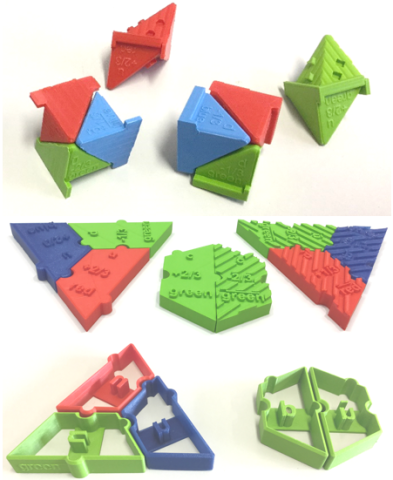Quark Puzzle

Build particle systems from quarks using this quark puzzle.
Description
Quarks are fundamental particles in the Standard Model of particle physics. They make up protons, neutrons and other exotic particles such as pions and kaons – but they are never found alone, always forming groups of two or three. This activity invites learners to discover the rules of quark combinations using a puzzle. Each puzzle piece represents a type of quark or antiquark, labelled with its electric and colour charge.
By physically combining the pieces, learners can build particle systems, understand charge conservation and explore the concept of colour neutrality. To find out more about CERN’s research in particle physics click here.
Page Overview
3D Puzzle Version
Material List
- 3D-printed parts. Download the 3D-printing files from here.
- Worksheet with guided activities and data tables. Download the worksheet here.
- Teacher manual with solutions. Download the manual here.
Instructions
3D-print the puzzle pieces. Students use these pieces to discover the rules that govern how quarks combine into composite particles. Each piece represents a quark or antiquark and is labelled with:
- A flavour (e.g. up, down, anti-up, anti-down).
- An electric charge (e.g. +2/3, -1/3).
- A colour charge (e.g. red, green, blue, or anti-colours).
The shapes of the puzzle pieces guide students toward valid combinations:
- Baryons are built from three quarks forming a cube.
- Mesons are built from one quark and one antiquark, forming a double pyramid.
Using the worksheets provided, students complete guided tasks such as:
- Building protons, neutrons, anti-protons, anti-neutrons,and pions.
- Recording the electric and colour charges of their combinations.
- Using evidence and reasoning to evaluate scientific claims (e.g. “Can a neutron have a charge of +1?”).
- Comparing the puzzle model to real particle systems, and identifying its limitations.
An introductory mission briefing challenges students to discover the rules of quark behaviour through trial and error.
2D Puzzle Version
Material List
- Paper puzzle pieces. Download the PDF of the paper puzzle pieces here.
- Scissors.
In addition to the paper version, we also provide a 3D printable version of these 2D puzzle pieces.
- 3D-printed parts (optional). Download the 3D-printing files from here.
Instructions
The 2D puzzle uses paper-printed or 3D-printed flat quark pieces with visible labels. The striped designs helps learners distinguish between colour and anti-colour charges.
- Combine pieces to form baryons and mesons, following the same charge rules as the 3D version.
- Explore which combinations are valid and record findings using the same worksheets as the 3D version.
Explanation
Quarks are elementary particles that make up protons, neutrons, and many other composite particles. They cannot exist on their own and always form groups called particle systems.
There are two main types of particle systems explored in this activity:
- Baryons: Made of three quarks or three antiquarks.
- Mesons: Made of one quark and one antiquark.
Each quark has two important properties:
- Electric charge: Either +2/3 or -1/3. The total electric charge of a valid particle system must always be a whole number (e.g. -1, 0, +1).
- Colour charge: Either red, green, or blue (or anti-red, anti-green, anti-blue for antiquarks). A valid particle system must always be colour neutral.
This rule of colour neutrality means:
- In baryons: one red, one green, and one blue quark combine to make white.
- In mesons: one colour and its corresponding anti-colour (e.g. red + anti-red) cancel out.
These rules are inspired by the Standard Model of particle physics and help learners model how quarks behave in real experiments, even if the puzzle pieces themselves are only a simplified version of reality.
Ideas for educators
- As a fun extension, you can even use a set of quark cookie cutters to build edible mesons and baryons. You can view the sheet here.
- For more independent students, we propose an open inquiry activity. You can download the open inquiry student worksheet here.
- You can also test this modified 2D puzzle design based on Gettrust's QuarkNet activity. You can view the sheet here.
- The article "3D Printable Quark Puzzle: A Model to Build Your Own Particle Systems" contains a more detailed description of the 3D puzzle pieces, together with ideas for classroom activities. Click here to read the paper.
- The article "The Quark Puzzle: A Novel Approach to Visualizing the Color Symmetries of Quarks" contains a more detailed description of the 2D puzzle pieces. Click here to read the paper.